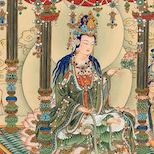Jodo Wasan 116
'Such beings are like people who, imbued with incense,
Bear its fragrance on their bodies;
They may be called
Those adorned with the fragrance of light.'
Nembutsu Saturation

One of the most wonderful times of my life was the first three or four years of my discovery of the nembutsu way. It was indescribably liberating, as it so often seems to be for so many who come to it for the first time. But it was also the time during which I became saturated with nembutsu - steeped in it. As the famous psychologist of religion, William James, has said, it was very like falling in love.
I knew very little about the actual ecclesiology of Jodo Shinshu at the time and almost nothing of Shinran Shonin. My meeting with him was some five years after my first meeting with nembutsu, in the form of a copy of the Jodo and Koso Wasan, which I bought directly from the Ryukoku Translation Centre. My text books at this time were essentially the Contemplation Sutra and the Amida Sutra. Both of these were available as off-prints - published by the Prajna Temple in Dixon Street, Sydney - of the Max Müller translations from the Sacred Texts of the East. I read them - and read them - until my copy wore out.
A Chinese-ordained monk (a prison chaplain working in Malaysia) gave me a wonderful and durable japa-mala. This was not the shortened kind we Shinshu followers use but a big voluminous set of beads - one hundred and eight of them - made, I think of nuts from a bodhi tree. This monk also taught me to chant nembutsu, while vizualising the Buddha as he is described in the Contemplation Sutra. I set aside time each day for this activity but also began taking every opportunity to recite nembutsu while alone. I set up self-styled nembutsu retreats.
These were enchanting times. I was also practicing Hatha Yoga and reading translations of the Pali Canon, having come to see Shakyamuni as the 'greatest yogi'. (It was at this time that I discovered the importance of faith (shinjin, Sk. shraddha) as the most vital step on the way to release from samsara. On one retreat I took a newly purchased copy of A Buddhist Bible, edited by Dwight Goddard and I still remember the exhilaration in reading the Surangama Sutra and the account of Mahasthamaprapta's nembutsu practice. This took me utterly by surprise, as I had thought that I was in for my first encounter with the Yogacara tradition. It was marvellous to find the nembutsu discussed in that context.
Nembutsu retreats and meditation practice extended to my friends. On more than one occasion I lead nembutsu recitation and visualisation based on the Larger Sutra, which I had newly discovered. Reaching out for a tradition of nembutsu followers, I made contact with key members of the Buddhist Churches of America and discovered, at last, the teaching of Shinran. This was a meeting with a teacher who had plumbed the depths of nembutsu practice and had a clear insight - or so it seemed to me - into the role of the nembutsu way as the path to nirvana for ordinary people.
The most gratifying event since that time was my trip to Kyoto for ordination (tokudo). It was here that I discovered that the Hongwanji is still home to many nembutsu people. It became clear to me that the Shin Buddhist community was a suitable spiritual home. For, at the daily morning service (jinjo gongyo), it seemed that there were many men and women of pure trust and devotion (shinjitsu shinjin): living examples of the seventeenth and eighteenth of Amida Buddha's forty-eight vows.
There were people whose nembutsu was driven by nothing other than pure trust and devotion, having no concern for anything but nembutsu and no concern for themselves; people saturated in and perfumed by Namo Amida Butsu. People whose very presence called out to us to follow them, to emulate them, to accept the inspiration, which they exuded. They did not have the rancid odour of sanctity or self-righteousness, just the demeanour of ordinary people, who knew - maybe - both how to work hard and also how to have fun and enjoy themselves. But they were people whose lives were steeped in Namo Amida Butsu. These people lived the nembutsu life, attending the daily observance every morning, to express their joy in the dharma and listen to the teachings of Shinran - a model for us all.
I have told this story to illustrate the fact that there is indeed a nembutsu way of life and a way of being that is in keeping with Namo Amida Butsu. It seems to me that the direction we should consider is towards active engagement with nembutsu as a living thing; the way of becoming steeped in it; the way of living a thankful and joyful life .
Namo Amida Butsu